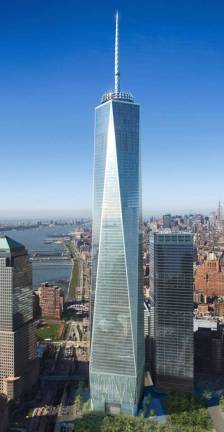Walking to the Freedom Tower

It's Sunday evening, and me and my friend Ruth feel like walking. We cut through Union Square, filled with protestors and, the way New York City does sometimes, the blocks pull us downtown. Looking down Sixth Avenue, we see the new addition to the horizon, a large addition, and the exterior, at least, is now officially complete. The Freedom Tower is lit red, white and blue and even from here, a mile away, it seems unreal-unreal because it's so much taller than anything around; unreal because I still see, even now, the two towers that once held down the lowest part of Manhattan. Before 9/11, I lived on the corner of Barrow and Bedford above Chumley's, that famous speakeasy where a secret door opened to one of New York's best bars. Chumley's (where I also worked) is closed today, thanks to a collapsed chimney and structural damage, but it wasn't collapsed when I heard the news that clear September morning, news that not one, but two planes had flown into the World Trade Center, the idea so absurd I heard a smirk in the newscaster's voice. I left my room and started walking downtown, the backdraft of something horrible pulling me forward as close as I could get. The flames looked so hot I imagined them melting steel, which is exactly what the jet-fuel fire was doing, and then I wasn't imagining anything anymore. The buildings fell. And all I could do, all any of us could do, was stare at the smoke-filled gap in our city's horizon, a familiar mouth with two punched-in teeth. Tonight, Ruth and I are walking downtown, pulled to the single tower. We have stories to tell, and certain streets, certain bars and restaurants, certain buildings along the way remind us of things worth sharing. And the walk itself is a story. I tell Ruth I used to run on these streets, the North Tower my destination. From Chumley's to the towers and back-that was my running routine. Just like the twin towers were part of so many people's routines before 9/11. You'd come up the subway steps and there they were. And then there was nothing. And now there's something. One thing. And that one thing inevitably leads to the stories we tell each other. One World Trade Center, the Freedom Tower, isn't just a building. And it isn't just a symbol-no matter how cynical we may be, the building stands symbolic, proclaiming, perhaps with excessive American vigor, that we can rebuild, that justice will prevail, that freedom cannot be destroyed. What the Freedom Tower is (and will be for a long time) is a catalyst for stories. We'll look at the tower and ask the question, always the same question, Where were you that day? Not the day this new tower was erected. But the day in modern American history, September 11th, 2001. This question starts the story I tell in a novel about two characters and how they get through 9/11's aftermath. They drink. They walk. They recount memories of a third character, a missing character, who died that day. As Ruth and I get closer, One World Trade Center becomes more unreal still. There's something about super skyscrapers that doesn't make sense. I've stood on many sidewalks looking straight up-at the Empire State Building, at the Sears Tower, at Taipei 101. One hundred stories is too far away. But this tower, lit up at night, is different. Associated with that morning twelve years ago, this building feels the opposite of free-it is bound to the past. The red, white and blue lights can look eerie as well as proud. We walk through the construction area and onto the overpass that straddles the West Side Highway. This time we're pulled by the Hudson. We stand by the river for a long time, not talking. When we turn around, the tower is there, but from this angle, the building looks quieter, more peaceful, the lighting almost tasteful. And it doesn't seem so imposingly tall. From here, the structure is manageable. And maybe that's the point. Head-on, the Freedom Tower is almost too much. But in a by-indirections-find-directions-out kind of way, this view from across the highway, with the Hudson River at our backs, makes the single tower feel less connected to memory, more self-defined, and so more real. New York City was large enough to encompass that horrible day twelve years ago. It's large enough to accommodate its newest skyscraper, 104 stories worth of concrete and steel. Adam Berlin teaches writing at John Jay College of Criminal Justice. His new novel The Number of Missing (Spuyten Duyvil press) is about post-9/11 New York City. --- Do you have a personal story about your neighborhood you'd like to share? Send submissions to editor.otdt@strausnews.com, with the subject line "My Story."